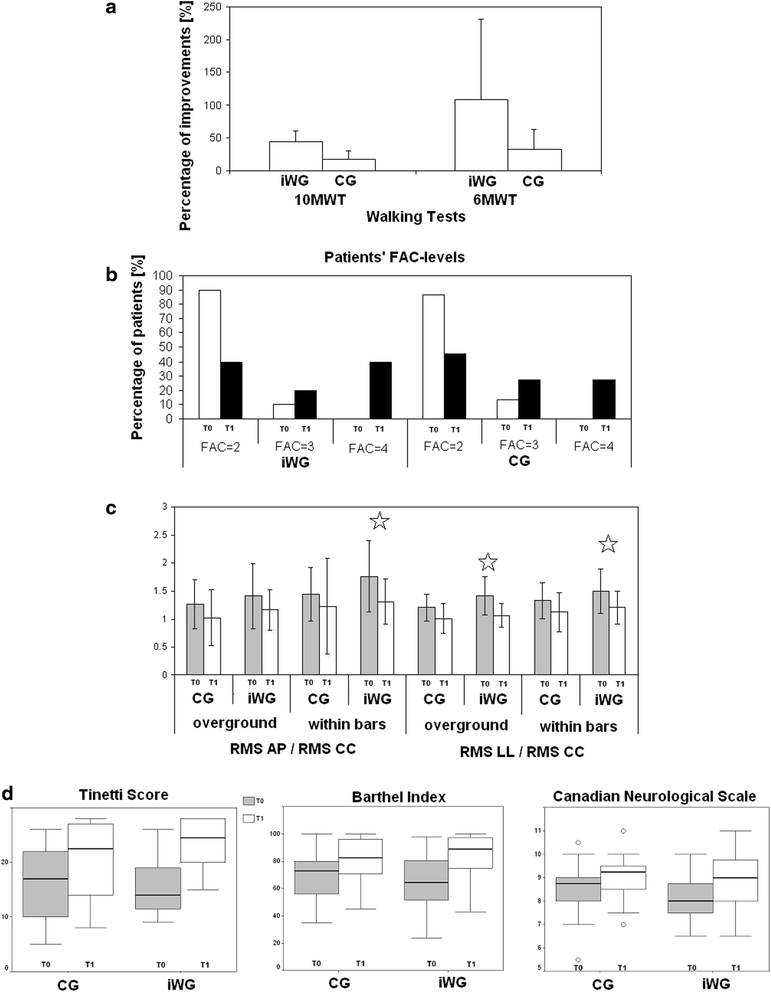Overground walking training with the i-Walker, a robotic servo-assistive device, enhances balance in patients with subacute stroke: a randomized controlled trial
- PMID: 27225043
- PMCID: PMC4880987
- DOI: 10.1186/s12984-016-0155-4
Overground walking training with the i-Walker, a robotic servo-assistive device, enhances balance in patients with subacute stroke: a randomized controlled trial
Abstract
Background: Patients affected by mild stroke benefit more from physiological overground walking training than walking-like training performed in place using specific devices. The aim of the study was to evaluate the effects of overground robotic walking training performed with the servo-assistive robotic rollator (i-Walker) on walking, balance, gait stability and falls in a community setting in patients with mild subacute stroke.
Methods: Forty-four patients were randomly assigned to two different groups that received the same therapy in two daily 40-min sessions 5 days a week for 4 weeks. Twenty sessions of standard therapy were performed by both groups. In the other 20 sessions the subjects enrolled in the i-Walker-Group (iWG) performed with the i-Walker and the Control-Group patients (CG) performed the same amount of conventional walking oriented therapy. Clinical and instrumented gait assessments were made pre- and post-treatment. The follow-up observation consisted of recording the number of fallers in the community setting after 6 months.
Results: Treatment effectiveness was higher in the iWG group in terms of balance improvement (Tinetti: 68.4 ± 27.6 % vs. 48.1 ± 33.9 %, p = 0.033) and 10-m and 6-min timed walking tests (significant interaction between group and time: F(1,40) = 14.252, p = 0.001; and F(1,40) = 7.883, p = 0.008, respectively). When measured, latero-lateral upper body accelerations were reduced in iWG (F = 4.727, p = 0.036), suggesting increased gait stability, which was supported by a reduced number of falls at home.
Conclusions: A robotic servo-assisted i-Walker improved walking performance and balance in patients affected by mild/moderate stroke, leading to increased gait stability and reduced falls in the community.
Trial registration: This study was registered on anzctr.org.au (July 1, 2015; ACTRN12615000681550 ).
Keywords: Floor training; Gait; Rehabilitation; Robotic-assisted therapy; i-Walker.
Figures



References
-
- Gresham GE, Duncan PW, Stason WB, Adams HP, Adelman AM, Alexander DN, Bishop DS, Diller L, Donaldson NE, Granger CV, Holland AL, Kelly-Hayes M, McDowell FH, Myers L, Phipps MA, Roth EJ, Siebens HC, Tarvin GA, Trombly CA. Post-stroke rehabilitation: clinical practice guidelines. Rockville: U.S. Department of Health and Human Services; 1995.
Publication types
MeSH terms
LinkOut - more resources
Full Text Sources
Other Literature Sources
Medical

